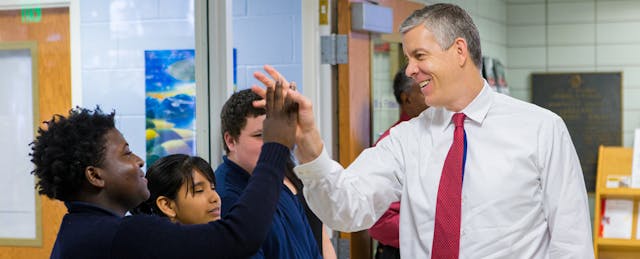Today, as never before, schools across the country are harnessing the power of technology. The merit of these efforts will be determined by whether they yield meaningful results to improve teaching and learning. Early indications show that, in the ongoing work to connect our students to 21st century digital learning opportunities, efforts from the federal government and our partners are meeting and even exceeding expectations. In just the past two years, according to a new report from EducationSuperHighway, 20 million more students now have access to high-speed connectivity at school.
Access to high-speed broadband in our schools and libraries is critical for America’s children. As more than 50 CEOs, including the heads of Facebook, Google and Microsoft, wrote in a letter to the Federal Communications Commission (FCC), “If our schools do not embrace technology and the Internet, our children will be unable to compete in the global economy.”
Technology and high-speed broadband can open new worlds of opportunity for our nation’s teachers and students, allowing them to access expertise and resources and engage and collaborate in new, exciting ways. And, as shown in a meta-analysis published in the Review of Educational Research based on 40 years of research, we know that technology in learning spaces has made a significant impact on student achievement time and again.
Yet for too long our classrooms have lagged behind the times. In June 2013, President Obama took the issue head on, calling on government and private sector leaders to close the Internet connectivity gap in our schools and libraries. At that time, thanks in large part to the FCC’s E-rate program—the nation’s largest education technology program—nearly all schools and libraries already had Internet access, but too many had insufficient bandwidth. The speed may have been enough for a typical American household, but it was inadequate for a school with hundreds of students and teachers. According to one analysis at the time, 63 percent of public schools—serving over 40 million students—lacked broadband connections capable of taking advantage of digital learning.
To close this gap, President Obama launched the ConnectED initiative, with a central goal of connecting 99 percent of America’s students to high-speed Internet within five years. The FCC and the U.S. Department of Education independently launched a series of initiatives to help meet or even exceed that goal. For example, the Department and the White House invited the private sector to supplement federal actions and help support cutting-edge technologies and professional development opportunities across our nation’s schools and libraries. The private sector has committed more than $2 billion in hardware and software support for schools. And nearly 2,000 districts across the country have taken the Future Ready pledge to use new connectivity to transform and personalize learning as called for in the newly-released 2016 National Education Technology Plan. The plan, along with Future Ready initiative, focuses on supporting leaders in taking advantage of new connectivity to improve student learning.
Meanwhile, the FCC launched a top-to-bottom review of E-rate, acknowledging that, in the 18 years since E-rate was established, technology has evolved and the needs of students and teachers have changed. The FCC has modernized the E-rate program, refocusing it on providing support for cost-effective, high-speed broadband connectivity capable of supporting one-to-one digital learning to schools and libraries.
And schools and libraries have responded by seeking a total of $3.9 billion in E-rate support this year, including more than $1.6 billion for internal Wi-Fi networks. This marks the first time since 2010, and only the third time in the history of the program, that all eligible Wi-Fi applications will be funded. These requests also reflect long pent-up demand at all schools and libraries, but particularly at rural schools.
Enough time has elapsed to see if these collective efforts are having an impact, and early signs show that the steps our agencies have taken are delivering results for which we’d hoped. A little more than two years ago, our government set a goal. We are meeting that goal, and the result is 20 million more American students now have expanded access to digital learning opportunities.
But our work is far from done. Rural and small town schools are nearly two-and-one-half times more likely to lack a fiber connection than their urban and suburban counterparts. Affordability is an issue, particularly in rural areas, where the median costs for high-speed connections are more than double the costs in urban and suburban schools. Millions more students and their teachers must be connected before we reach our goals. And teachers need support and professional learning opportunities to ensure technology can close equity gaps and personalize learning for all students. Because, research like this report out of Stanford University’s Center for Opportunity and Policy in Education shows that the active use of technology can make the difference in improving student learning.
Through continued work together, we can ensure that a fast-growing world of technologies brings remarkable possibilities for teaching and learning—helping teachers to do their vital work and making school even more engaging for students.


